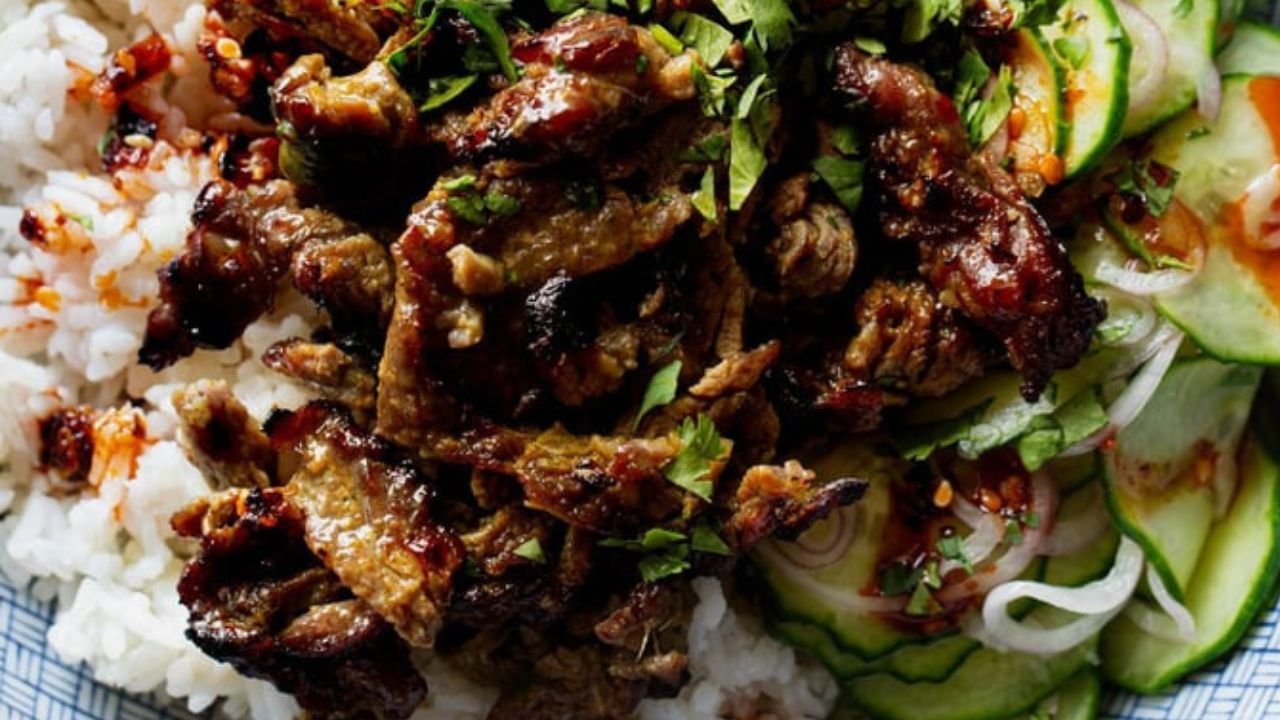Introduction
In the realm of grilled meats and skewered delicacies, few dishes evoke the same universal appeal as Garlic and Black Pepper Beef Skewers. Juicy, tender beef marinated and seasoned with aromatic garlic and bold black pepper, then grilled to perfection, creates an irresistible combination of flavors and textures. These skewers are a celebration of simplicity and boldness, combining robust spices with the smoky char of the grill, making them a popular choice for barbecues, street food vendors, family dinners, and culinary experimentation alike.
This comprehensive guide will delve into every aspect of this dish—from its flavor profile and cultural roots to detailed recipes, preparation tips, variations, health considerations, and presentation ideas—empowering you to craft perfect skewers and adapt them to your taste.
Origins and Cultural Context
The Global Appeal of Grilled Skewers
Skewered meats are among the oldest cooking techniques, dating back thousands of years across many cultures—from Middle Eastern kebabs and Mediterranean souvlaki to Southeast Asian satays and African brochettes. Their popularity stems from simplicity, portability, and the ability to infuse flavors deeply into the meat through marination and grilling.
Influence of Asian and Middle Eastern Flavors
While garlic and black pepper are globally used spices, their prominence in Asian and Middle Eastern cuisines highlights their importance in flavoring grilled meats. In particular, Chinese, Vietnamese, and Indian cuisines often feature garlic and black pepper as key aromatics.
Western Barbecue Traditions
In Western countries, especially in North America and Australia, beef skewers or kebabs are staples of outdoor barbecues, often seasoned with pepper and garlic, reflecting simple, hearty flavors that emphasize the meat’s natural qualities.
Fusion and Modern Interpretations
Today, chefs and home cooks blend traditional techniques with contemporary flavors, creating dishes like garlic and black pepper beef skewers that showcase bold, savory profiles with a hint of spice and aromatic pungency.
Flavor Profile and Sensory Experience
Core Flavors
- Garlic: Provides pungent, aromatic, and slightly sweet notes that deepen with cooking.
- Black Pepper: Offers pungency, heat, and a fruity, earthy aroma that enhances the beef.
- Beef: Juicy, tender, with a rich umami flavor that serves as a perfect canvas for seasoning.
- Marinade and Seasonings: May include soy sauce, oyster sauce, sesame oil, or other ingredients for depth.
Sensory Layers
- Aromatics: Fragrant garlic and freshly cracked black pepper.
- Taste: Savory, with a balance of heat and aromatic pungency.
- Texture: Juicy, tender beef with a slight char and crisp exterior.
- Crunch and Juiciness: From grilled caramelization and the natural juices of beef.
The Experience
The dish offers a complex yet straightforward flavor profile—robust, savory, with a hint of spice and aromatic warmth—making it a crowd-pleaser and perfect for pairing with various sides.
Ingredients and Equipment
Main Ingredients
- Beef: Choose cuts suitable for quick grilling—sirloin, ribeye, tenderloin, or flank steak. Cut into uniform cubes, typically 1 to 1.5 inches.
- Garlic: Fresh garlic cloves, minced or grated.
- Black Pepper: Freshly cracked black peppercorns or pre-ground pepper.
- Marinade/Sauce Components:
- Soy sauce or tamari
- Oyster sauce or hoisin (optional for depth)
- Sesame oil (for aroma)
- Rice vinegar or lime juice (for balance)
- Honey or brown sugar (for caramelization)
- Green onions or scallions (optional)
- Red pepper flakes (optional for extra heat)
- Oil: Neutral oil like vegetable or canola for grilling.
Additional Flavors (Optional)
- Ginger, grated
- Five-spice powder or cumin
- Chili paste or fresh chili for heat
- Fresh herbs like cilantro or Thai basil
Equipment
- Skewers (wooden or metal)
- Grill, barbecue, or broiler
- Mixing bowls
- Knife and chopping board
- Basting brush
- Tongs
- Meat tenderizer (if needed)
Preparation Techniques and Step-by-Step Recipes
1. Choosing and Preparing the Beef
- Selection: Opt for tender cuts that cook quickly and remain juicy—sirloin, ribeye, tenderloin, or flank steak.
- Trimming: Remove excess fat and silverskin for even cooking.
- Cutting: Slice the beef into uniform cubes about 1 to 1.5 inches, ensuring even cooking and ease of skewer threading.
2. Marinating for Flavor and Tenderness
A good marinade not only infuses flavor but can help tenderize the beef:
Basic Marinade Recipe:
- ¼ cup soy sauce
- 2 cloves garlic, minced
- 1 teaspoon freshly cracked black pepper
- 1 teaspoon sesame oil
- 1 teaspoon honey or brown sugar
- 1 tablespoon rice vinegar or lime juice
- Optional: a small amount of grated ginger or chili paste
Method:
- Combine all ingredients in a bowl.
- Add beef cubes, ensuring they are fully submerged.
- Cover and refrigerate for at least 30 minutes, ideally 1-2 hours for deeper flavor.
3. Assembling the Skewers
- If using wooden skewers, soak them in water for 30 minutes to prevent burning.
- Thread the beef cubes onto skewers, leaving space between pieces for even heat exposure.
- Optionally, alternate beef with vegetables like bell peppers, onions, or zucchini.
4. Grilling or Cooking the Skewers
Grill Method:
- Preheat the grill to high heat.
- Clean and oil the grates.
- Place skewers on the grill, turning every 2-3 minutes for even cooking.
- Cook for about 8-12 minutes total, depending on thickness and desired doneness.
- Baste with marinade or oil during grilling for extra flavor and moisture.
- Aim for a nicely charred exterior while keeping the interior juicy.
Broiler Method:
- Preheat oven broiler.
- Place skewers on a broiler-safe pan or rack.
- Broil 4-6 inches from heat source, turning every few minutes.
- Keep an eye to prevent burning.
Pan-Frying:
- Use a hot skillet with a little oil.
- Cook skewers in batches, turning to brown all sides.
- Finish with a brief rest period before serving.
5. Resting and Serving
- Let the cooked skewers rest for a few minutes to allow juices to redistribute.
- Serve hot with your choice of sides.
Variations and Flavor Enhancements
Spicy Version
- Add chopped chilies or chili paste to marinade.
- Sprinkle chili flakes or hot sauce after grilling.
Asian-Inspired Twist
- Incorporate ingredients like five-spice powder, ginger, or sesame seeds.
- Serve over steamed rice or rice noodles.
- Garnish with chopped green onions and fresh cilantro.
Middle Eastern or Mediterranean Style
- Use za’atar spice blend or sumac.
- Serve with pita bread, hummus, or tabbouleh.
American or Western Style
- Brush with barbecue sauce after grilling.
- Add smoked paprika or cumin to marinade.
Vegetarian or Vegan Alternatives
- Use firm tofu, tempeh, or plant-based meat alternatives, marinated similarly.
Health Considerations
Nutritional Profile
- Beef is a rich source of high-quality protein, iron, zinc, and B-vitamins.
- Moderation is key due to saturated fat content.
- Marinating with soy sauce and oils adds sodium and calories—use low-sodium soy and control portion sizes.
Tips for a Healthier Version
- Choose leaner cuts.
- Use minimal oil and watch portion sizes.
- Serve with vegetables or salads to balance the meal.
- Incorporate whole grains like brown rice or quinoa.
Allergen and Dietary Notes
- Soy-based marinades may not be suitable for those with soy allergies.
- Always check ingredient labels for gluten if using soy sauce.
- Adjust for dietary preferences (e.g., gluten-free tamari).
Presentation and Pairing Ideas
Plating
- Serve skewers on a bed of steamed rice, bulgur, or couscous.
- Garnish with chopped herbs, sesame seeds, or sliced green onions.
- Offer dipping sauces such as spicy mayo, tahini, or soy-based dipping sauces.
Beverage Pairings
- Light beers like pilsners or lagers.
- Red wines with soft tannins (e.g., Pinot Noir).
- Non-alcoholic options like iced green tea or sparkling water with lime.
Side Dishes
- Grilled vegetables
- Fresh salads with citrus vinaigrette
- Flatbreads or pita
Presentation Tips
- Arrange skewers attractively on a platter.
- Use vibrant herbs and colorful vegetables for visual appeal.
- Consider serving with small bowls of sauces or condiments.
Cultural Significance and Variations Worldwide
- Middle Eastern: Similar kebabs seasoned with spices like cumin, coriander, and sumac.
- South Asian: Tandoori-style beef skewers marinated with yogurt and spices.
- East Asian: Yakitori-style beef with garlic and pepper, often glazed with soy or teriyaki.
- Western: BBQ beef skewers with smoky flavors and spicy rubs.
This dish’s versatility allows it to be adapted to various cultural tastes, emphasizing the universal appeal of grilled, seasoned meats.
Tips and Secrets for Perfect Skewers
- Marinate thoroughly: For maximum flavor, marinate for at least an hour.
- Uniformity: Cut beef into uniform sizes for even cooking.
- Preheat grill: Ensure high heat for proper searing.
- Don’t overcrowd: Leave space between pieces to promote even cooking.
- Control flare-ups: Keep a spray bottle of water handy to manage flare-ups caused by dripping fat.
- Use fresh ingredients: Fresh garlic and black pepper provide the best aroma and flavor.
- Test for doneness: Beef should be cooked to your preferred level—medium-rare to medium for tenderness, but fully cooked for safety.
Final Thoughts: A Classic Reinvented
Garlic and Black Pepper Beef Skewers epitomize the essence of simple yet bold flavors. Their smoky, savory profile combined with aromatic garlic and pungent black pepper makes them a perennial favorite across cuisines and occasions. Whether grilled over an open flame, cooked on a charcoal barbecue, or broiled indoors, these skewers deliver satisfying results every time.
With the flexibility to adapt spices, marinades, and accompaniments, this dish offers endless opportunities for customization, allowing you to explore different flavor profiles—from Asian-inspired to Mediterranean, or smoky Western styles.
Mastering this dish means understanding the importance of quality ingredients, proper marination, and precise grilling techniques. It’s a perfect choice for outdoor gatherings, family dinners, or special occasions, showcasing the universal appeal of well-seasoned, perfectly cooked skewered meats.

